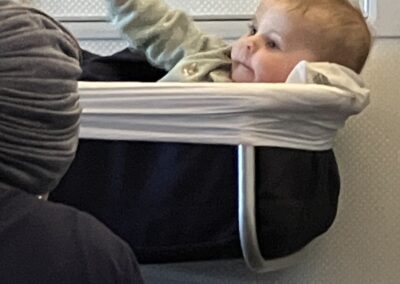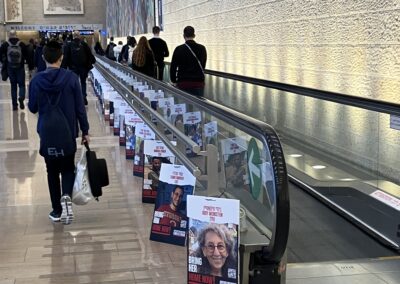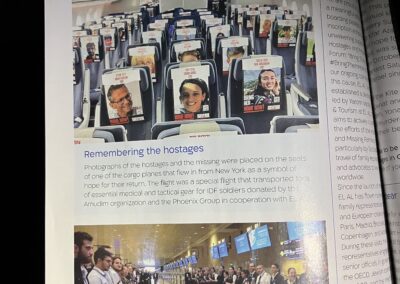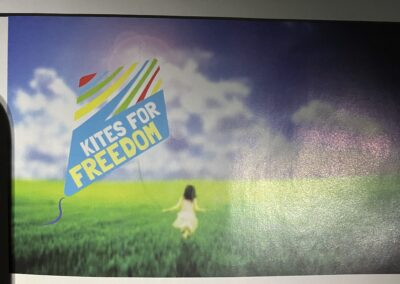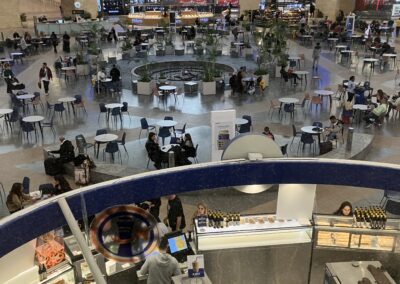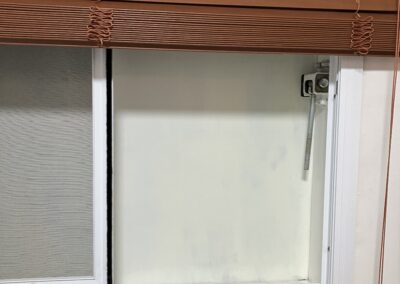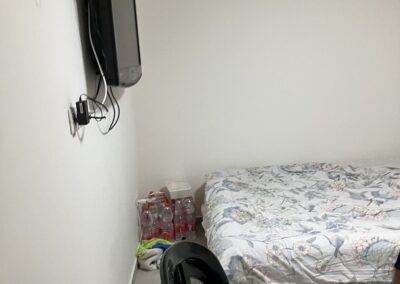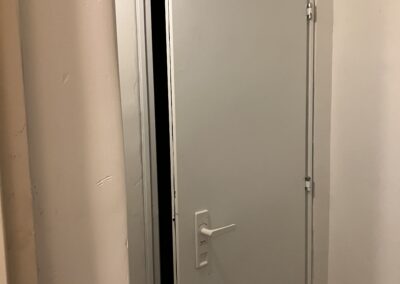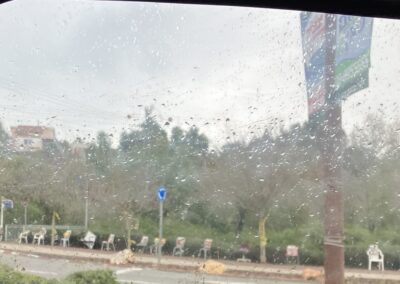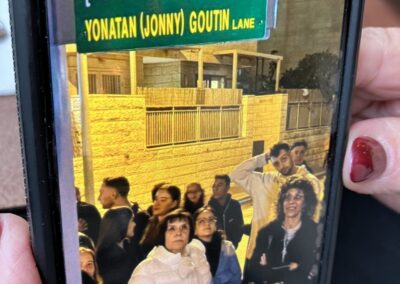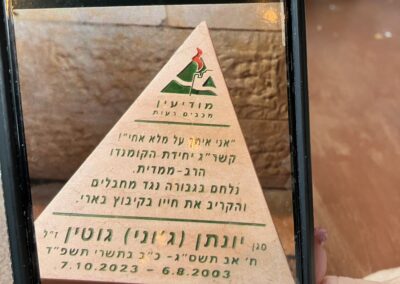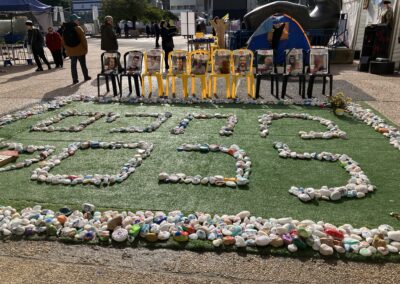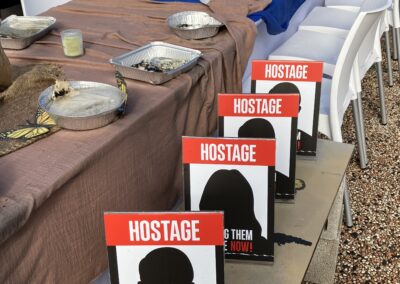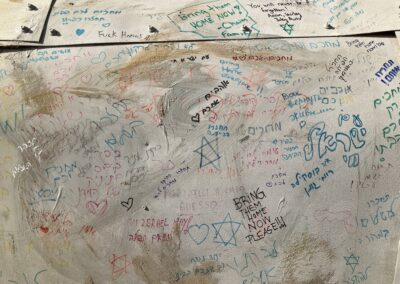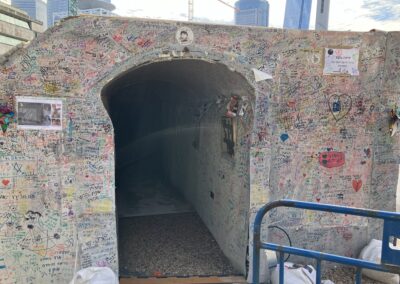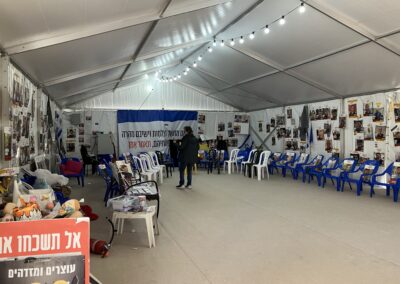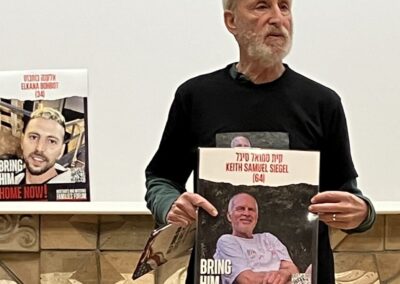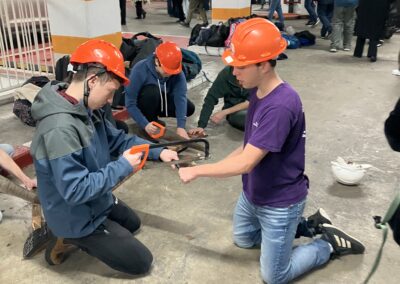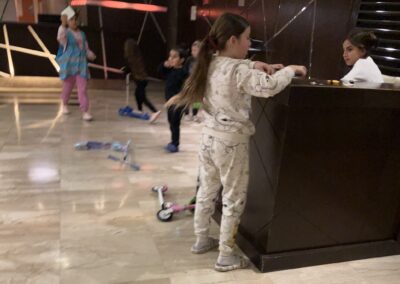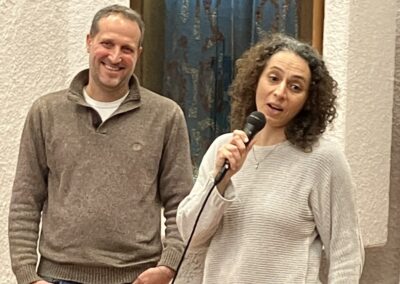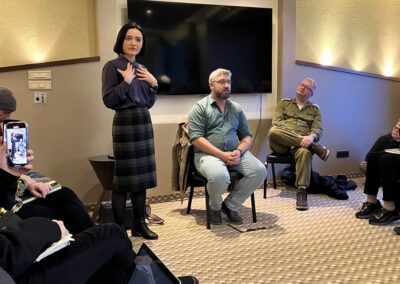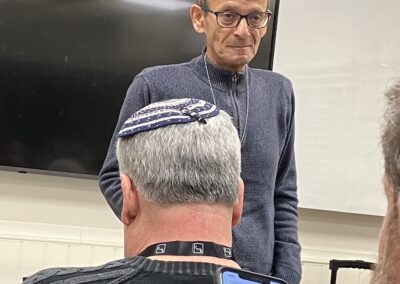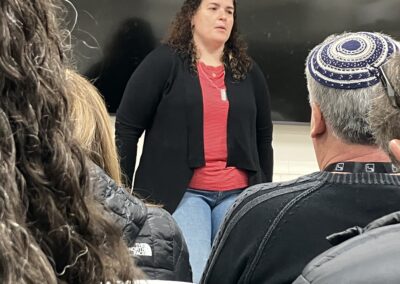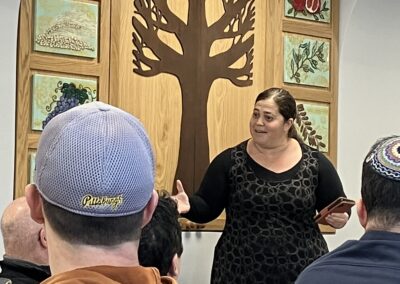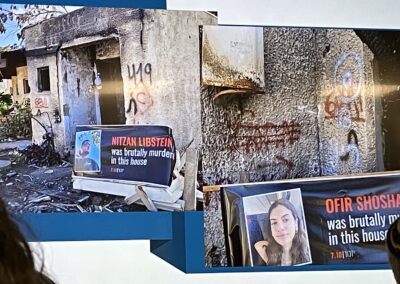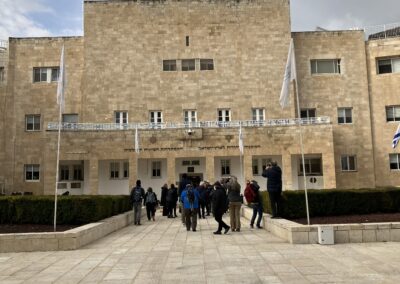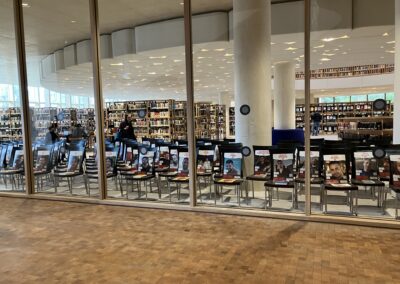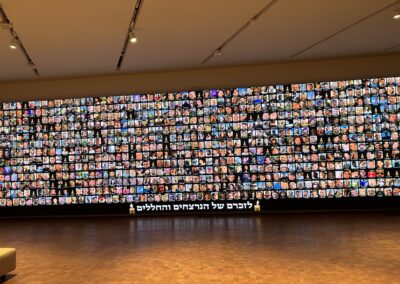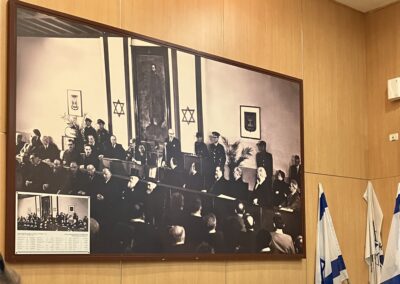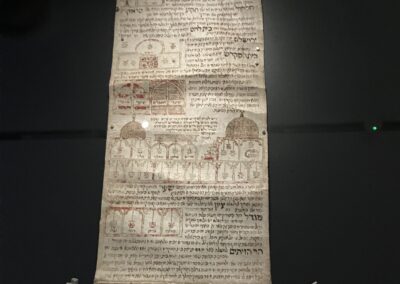Day 1 – January 23-24 Traveling
It’s 11:30 p.m. on Wednesday, and I am finally seated on the aisle on the plane (23h), surrounded by a high school basketball team with the manager next to me. It’s been a long day. I arrived from Rochester at 5:30 p.m. and went directly over to Terminal 4 (international flights) and had forgotten that there are no restaurants in the terminal – just one measly Dunkin Donuts kiosk. The El Al counter opened up at 8:30 p.m. Most astounding is that while waiting on line, the person behind me recognized me before I her (and I was even wearing a mask) – it was Yael Katz, whom Alan and I had befriended years ago when she worked as an educator for the Jewish Agency and participated in the Rochester-Modiin Partnership program. She had come to Rochester with Israeli teachers 3 years in a row when I was still working at the Jewish Federation and directly involved. Yael had also decided to go to HUC and was ordained just this past year at age 50. She told me she had so many activities planned for her fiftieth year on earth and her new profession – all cancelled. More significantly, she has two sons in the army, both stationed in Gaza. This was to be the first Shabbat since October 7 that both of them would be coming home and her excitement and momentary happiness to see them both were palpable. Friday is her husband, Chen’s birthday, and there was no better present for him.
The captain’s usual introductory message at the beginning of the flight included a prayer at the end for IDF soldiers and a passionate call to “bring them home.” Also attached to this email are a few pics from the inflight magazine dedicated to efforts to help those in need during this crisis, a baby on the plane who lifted the spirits of everyone close by, the emptiness of an otherwise busy airport terminal, and the posters of the hostages lining the exit ramp. El Al has also modified its logo everywhere to feature “#Bring Them Home.” The country is truly mobilized everywhere and by everyone.
As luck would have it, I landed a seat next to Eli, a businessman from Petah Tikvah, too old for even the reserves, but most assuredly devoted to volunteering wherever needed since October 7. He was in North America, actually in Toronto, with a high school basketball team who enjoyed their respite tournament away from the war for a week, but ultimately ended up in fourth place. Most significant is that Eli is now cooking for army units on the Lebanese border on Mondays and Wednesdays and delivering the meals directly to the units or to a “middle person” if the food’s destination is unsafe for civilians. He also buys helmets for the soldiers and special shoes. He indicated that most of the money he uses comes from donations and when necessary, he kicks in the rest. I decided that Eli would be the first recipient of the monies I am carrying, so generously donated by Temple B’nai Israel congregants and others. He showed me several videos of the meals he prepared, the soldiers eating the food both at their bases and at locations in the field, and their genuine gratitude for this special treatment. Eli and I shared family photos, especially of his son-in-law, wounded in Gaza, who has over 100 pieces of shrapnel in his body, which will remain where they are, according to all medical advice. No degree of separation! We exchanged contacts and he plans to send me videos of his “meals in the fields.”
It’s now Thursday evening, having been kindly picked up at the airport (my suitcase was the second to last to appear on the baggage belt – my usual luck, or lack of) by our relative, Vicky, and having settled in her lovely apartment in Modiin, eaten a delicious dinner (I declined both meals served on the plane), and now finishing this email.
Laila tov and Shabbat shalom to one and all!
1.26.24 Friday – Hanging at Vicky’s
I woke up to continuing howling winds and driving rain, apparently the worse weather day in Modiin this winter. Winds are still howling at 11:00 a.m. but rain has stopped and sun may be peeking through. Temperature remains in the low 50’s in central Israel. It’s a sedentary day for me to catch up with Vicky on all kinds of family and country trivia. I had hoped to go to services this evening at Yozma, where Vicky’s family have been active members for years. That said, the family decided to gather at a restaurant in Rehovot for her grandson, Nadav’s 22nd birthday (son of Natan and Sigal). I chose to be with family, however strange it feels not to engage in the usual Shabbat rituals.
Now, it’s mid-afternoon a—wind continues to howl. Too much time to think. . . I imagine that our CCAR group (which begins Sunday evening) will engage in the many facets of the crisis—from hostages, to military strategies, to humanitarian aid, to economy, to survivors, to short and long term trauma, to Israel’s stance on the world stage, etc. Today, I am reading some bios of individual hostages as well as perseverating on the horrific conditions through which they may be living right now (and I pray still living), as well as the psychic pain of survivors who intimately know hostages and victims.
The following blurb (italicized) was in today’s “Forward:”
Tal Schechter said he was supposed to go with his best friend, Amit Buskila, to the desert rave on Oct. 6, but at the last minute sold his ticket to May Naim, 24, who was murdered the next morning around the time Hamas terrorists abducted their friend. Guilt and anxiety paralyze him, especially at night. He needs a prescription to sleep.
Three times each week, Schechter is in Hostage Square handing out posters of hostages, including ones of his friend, to keep up the pressure for their release.“The pain of it,” he told me. “Every day. Just pain.”
Of course, pain is pain, for whatever reason. Still, emotional pain is less when it is not personal.
I look forward to visiting Rabbi Miri Gold and David Leischman tomorrow at Kibbutz Gezer. To call them dear friends is an honor and privilege. Miri is single-handedly responsible for a long, but successfully fought Supreme Court case whereby the government now pays the salaries of reform and conservative rabbis along with orthodox rabbis.
David built the first baseball field in Israel many moons ago on the kibbutz and was a force for the sport in Israel. Their youngest son, Alon, is now an assisting pitching coach for the Cincinnati Reds. I love being around celebrities! I expect to have deep conversations with them both, especially knowing that the brother of one of their Gezer friends is a hostage. Two of their three children and their families also live on Gezer – a treat to see them all. We met David and Miri and their little ones 4 decades ago when David served as the New England Shaliach (emissary from Israel), as we spent our summers together at Eisner camp.
Shabbat shalom – wishing you all a restful and relaxing Sabbath day!
1.27.24 – A Visit with Rabbi Miri Gold and David Leischman at Kibbutz Gezer
The day began with continuing rain, thankfully to end by 4 p.m.
David picked me up in Modiin at 10 a.m. We drove to Gezer to pick up Miri. They both insisted that we eat at Samir’s restaurant in Ramle. Samir z”l was a Greek Orthodox Arab whom the Leischman’s befriended a very long time ago. Indeed, when Samir passed away a few years ago, David was considered an immediate member of the family during their 3-day shiva period. Samir’s son Jhaleel runs the restaurant. He is also partners in a second restaurant in Berlin with a Jewish Israeli resident of Berlin. That restaurant is called “Knaan” (Canaan), and offers the same delectable array of mezza (middle eastern salads) and grilled meats. All the servers and cooks are family members, who greeted us warmly and attentively. The salads included hummus, beets, green salad with pomegranate juice, grilled eggplant, eggplant with tehina, matbucha, tomatoes in tehina, and a few other plates that I did not try (no room on the plate).
By the time we left Ramle, the sun came out—finally. I think I will shed my galoshes tomorrow.
Back at Gezer, the stories spilled out. . . .along with the ins and outs of the Leischman children and grandchildren, who all have on the houses on the kibbutz (which, by the way, is privatized, meaning each house is owned privately even though money for a few communal needs are still pooled together). Also present was an old friend of David’s, David Nitzan, who is a senior social worker for the government. The latter David has been moving around since the day after October 7 to directly affected Israelis to coordinate social needs and, also, support individuals. He had just finished a month at Rosh Hanikra in the north where most of the residents had already been moved to safer spaces. Quite surprisingly, Nitzan is moving tomorrow for a month to Kibbutz Nir Yitzchak, our nephew’s kibbutz. I described our nephew and hoped both would meet there. Nitzan told me that most of the surviving residents of Nir Yitzchak are now staying in the two hotels in Eylot, a location just north of Eilat, but hoped they would have permission to return to their homes in a few months. Our nephew is living at the kibbutz because he is the chief mechanic of the farm machinery, needed for the ongoing tasks of harvesting and milking cows. He is living under the watchful guard of IDF forces and sleeps in his safe room (Mamad) at night.
One of the only commercial business flourishing at this moment is the building of safe rooms for those who live in homes built before safe rooms were a requirement. Our friends, Miri and David, had theirs built last year to the tune of 70,000 Israeli shekels. I sat in the safe room for 10 minutes and felt briefly both claustrophobic and anxious, and also somewhat guilty knowing I could leave at any time. Right now, their small bedroom-sized safe room contains a double bed, a heater, bottled water, and one chair. I asked why no porta potty? David: “We will never be in this room for that long!” I reminded him that our nephew remained in his mamad almost 2 days, but David shrugged. It could be that Kibbutz Gezer is not a worthy target. David knows much more than me.
David, Miri and their 2 adult children (without spouses and grandchildren) were in New York on October 7 attending a family wedding. Miri officiated at the wedding, beginning at 4 pm that day. She looked over the bride and groom and saw her 42-year-old daughter crying in a front row. A phone message not only let them know what was happening in Israel, but announced the murder of a good friend of the daughter’s on Kibbutz Be’eri. Simultaneously, the older son received an alert from his unit that he needed to return to Israel immediately. Within 3 days two of the three children found spaces on a cargo plane, the youngest son took a commercial flight to Detroit-LA-Greece, and then hopped a flight on Isra-Air to Israel, sitting in the cockpit. Miri and David connected with the NY office of the non-profit Achim v’Achayot Laneshek, literally Brothers and Sisters in Arms. This grass-roots organization had initially been created to mobilize protests against the Reasonableness Law and the present extremist government. The organization pivoted immediately after October 7 responding to all the needs of Israelis due to the crisis. In the eyes of Israelis, they have responded more effectively than the government and have unexpectedly unified all sectors of the Israeli society in their efforts. As Miri and David’s flights home on Delta were cancelled, the organization somehow got them seats on an unmarked plane from JFK to Cyprus, and then a transfer to an unmarked plane to Israel – compliments of an anonymous philanthropist. This same story played out all in many countries where Israelis were found at that moment.
Miri shared options for donations that were hitherto unknown to me. The need to build strong and large safe rooms for the daycare center babies. Indeed, Gezer is building two of them, with a shortfall of $30,000. With our personal connection, I offered to help with this fundraising upon my return home. “My Table” is an organization that is buying supplies and offering services for families of reservist soldiers who have lost the income of their spouses.
Last few thoughts for tonight:
Miri’s son, Arishai, is serving in Khan Yunis (southern Gaza). It turns out that one of his fellow soldiers, a grad student at Columbia University who came back to Israel to serve, had approached the unit commander asking why drones are not being used to penetrate tunnels and other buildings looking for people and/or weaponry, which would certainly minimize harm to humans. The commander listened and challenged the soldier to raise money to purchase drones for this specific unit. He raised the money on social media for about 60 drones which this unit is now using to ferret out guns. It’s a wonder that the IDF is not using drones everywhere now, but I am not a military strategist.
I continue to question (along with most Israelis not on the front) what is fact and what is fiction in all we read and watch on the news. I can say that all I have heard from Israelis since my arrival, whether “left” or “right” is that they are living through a nightmare, and “first returning of hostages, then decomposing Hamas, then we’ll talk.”
Wishing you all an easy and hopeful week ahead!
1.28.24 Modiin – Tel Aviv
I had breakfast at the Garden Café in Reut with Aviva Dvir and Yonat Stav, Director and Program Assistant respectively of the Rochester / Modiin Partnership. Aviva and I were the initial Co-coordinators of the Educational Exchange, beginning in 2003 and have remained dear friends from day 1. Yonat came on many of the teacher trips as well. We caught up on the status of partnership projects and what our local Rochester Jewish Federation has been doing for Modiin since October 7. There was an initial non-specific donation of $250,000 and then a follow-up $100,000 to purchase an armored vehicle for Modi’in’s Kitat Konnenut—a kind of local militia responsible for patrolling the city, in the absence of army units or enough police coverage. Later in the day, I asked our nephew about these militias. He shared that in kibbutzim, they have been replaced with multiple cameras around the periphery but there are cities that are too large for camera coverage and too small for the presence of army units (especially now), so local militias are being established for protection.
All the above shared, I spent a glorious 3 hours with Ronit and Sol at a fish restaurant right on Tel Aviv beach – they are both engaged in the conversation of the crisis and also thinking towards the future, Sol taking classes online towards another degree in mechanical engineering and Ronit attending classes in person for manufacturing management while working as a security guard for the city of Tel Aviv. Although many of their friends have ostensibly left Israel for good, they want to visit the US but will always remain in Israel.
Our mission finally gathered at 5:30 this evening at the hotel—39 Reform rabbis and a few spouses, from all over the US, and one from Zurich. As a newbie, I only recognized those who have known me as Alan’s spouse and Noam’s Mom, but look forward to developing new friendships with these colleagues. Uri Feinberg, tour educator extraordinaire, will guide us.
- We have been with Uri on many trips. He is energetic, and full of knowledge and stories, and never at a loss for words. Tonight, he was very sad and at a loss for words. Our group was his first to lead since October 8. He said he is heartened and strengthened by our presence and is looking for inspiration from us. He encouraged us to share our perspectives with Israelis freely, a notion that in the past seemed to be considered in the category of “not our business to dictate what Israel should think and do.”
- Rabbi Hara Person, Chief Exec of CCAR and leader of the group, explained why we are not going to tour the Gaza Envelope, contrary to the wishes of many of the participants. (At present, Israel is allowing foreigners to visit Be’eri and Nachal Oz, two of the most decimated kibbutzim to view the devastation firsthand.) Hara explained that it’s truly not safe as no miklat– shelter is big enough for our group should a red alert be sounded, and more importantly, not to ascribe to “disaster tourism.” It is more important to bear witness to the people who live there, who are now refugees in safe places. And, indeed, we will go to Mishmar Ha’Emek on Tuesday to talk to the survivors of Nachal Oz, who were all transferred there.
- Reform Rabbi Gil Kariv, now a Knesset member, spoke brilliantly, and at length to our group on his perspective of the crisis. I took copious notes and happy to share upon request. Basically in agreement with Uri, he urged us and all Israelis to zoom out to the bigger picture, i.e., Hamas is a proxy for Iran, who has now the military capacity to challenge Israel on all fronts, comparable to 1948, and Israel must do what is necessary to maintain and develop the support of a Western Coalition, headed by the US. There were many more nuances to this conversation, but suffice to say that his main message was that this time Israel cannot achieve its goals alone and must listen and work with its allies.
1.29.24: Tel Aviv – Haifa
What a day of contrasts, fluctuating emotions, and uncomfortable conversations – exactly what this mission is all about!
On to “Gisha,” – meaning “approach,” another not for profit organization that advocates and fights in Israeli courts for Palestinian human rights. One of their premises is that Israel controls Gaza’s borders, air space, sea space, electro-magnetic space, and thus is legally obligated to provide humanitarian aid. These are brave young folks dedicated to alleviate Palestinian suffering. From my perspective, I did not trust their statistics nor did they seem to have a deep understanding of the complex issues at play, but I did admire their idealism. When asked what the “Day After” will look like, they deferred to the only option for them: insure that UNWRA will be fully functionable in Gaza. I will leave it at that.
On to Haifa for a few days to explore initiatives between Arabs and Jews in this mixed city at this very moment, and to interface with Reform rabbis serving the internal refugees. On the way, we experienced our first RED ALERT as 10 rockets fell on south Tel Aviv. For the most part, they were intercepted by Iron Dome but the detritus of both friendly and enemy missiles fall everywhere. We were on the periphery of the affected area so our alert was for less than 15 seconds. That said, all vehicles follow protocol: our bus parked on the side of the highway and we crouched below the window line. I had a moment, but it was more of empathy for all our Israeli kin who live permanently under these conditions. I now have the RED ALERT app on my phone.
We arrived in Haifa without further incident, where we heard another powerful presentation (and it was 7 p.m. already – good thing I brought energy bars and Hershey candy enough for our entire group) by Anna Kislanski, head of IMPJ, Israeli Movement for Progressive Judaism (their URJ). Anna had previously visited Temple Sinai. She spoke of the amazing work of Reform rabbis in Israel and the proliferation of Reform congregations. Of note is that the Reform movement is doing Havdalah every Saturday night in Hostage Square and attracting hundreds to sing together, egalitarian style. Also, the refugees from the Gaza Envelope are almost exclusively being served by Reform rabbis in the places where they have been resettled.
Lastly, refugee families are living in every hotel, including the Dan Panoramas in every city, where we are staying. Tonight, there were at least 8 young children on their scooters ramming through the hotel lobby. At one point, one speeder rode over the toes of the hotel manager standing near us. I had to laugh.
Again, if you have interest in more details about our conversations here, happy to share. Hope you are all well. I am fine physically, but assuredly holding the weight, albeit briefly, of an unsustainable situation here.
1.30.24 Haifa
Our day began at 8:30 a.m. and ended at 8:30 p.m. The rain never stopped – a physical reality paralleling the dark and uncertain mood.
Our hotel, Dan Panorama, is housing internal refugees from Shlomi, a small town in the western Galilee, and Kiryat Shmona on the Lebanese border. The children have the run of the hotel, including using the lobby hallways as their scooter park (see photo). The children attend local schools for now and teen youth groups come in the afternoon to provide activities and supervision, as a break for the parents. The older residents sit in the lobby, knit hats for soldiers and play cards, because there is nothing else to do.
We began our encounters at Beit Hagefen, an Arab Jewish Culture Center dedicated to pluralism and respectful discourse between those of diverse faiths and cultures. Assaf, the Jewish Israeli CEO, assured us that all decisions and projects are driven by a team that has an equal number of Arabs and Jews. The encounters here are personal and deep, aimed at enabling every participant (primarily high schoolers and educators) to explore all their identities and fears, and be able to articulate who they are to others, mainly through art. One installation (photo attached) on the floor seemed to be an assortment of oriental rugs with a blurry design. It turned out that it was created with local spices leading to conversations about what makes a home, including smells, tastes, and locations. Fascinating. Naveen, the Arab Druze presenter (photo), defined their concept of the “Third Space” where folks encounter each other and bond through their stories. She initiates conversation around food and its perceived origins, the language of curses, and clothing – how we identify with these items and value them. It was our first encounter with an Israeli Arab. We were warned that most Israeli Arabs are not talking at all since October 7, out of fear of repercussions. Naveen, on the other hand, shared: “Israelis not fighting another army, but rather a terrorist organization and who knows what Hamas is doing to their own people. Sometimes I feel ashamed. I don’t take long showers because so many hostages cannot right now.” Her tears were infectious.
Our next stop was at a mall food court for lunch (of course). Not wanting a full lunch, I opted to purchase a warm roll in the bakery and a chocolate bar. I did sit down and shmooze with our group, including Rabbi Liora Kelman, daughter of Rabbi Naama Kelman, Dean Emerita of HUC in Jerusalem. I should say at this point that we have been accompanied for each visit with 2-3 Israeli Reform rabbis, and there are at present 130 Reform rabbis in Israel, a revelation for me. One of the purposes of this mission was and is to support this group of Rabbis who are working day and night to serve their traumatized and fearful congregants, all the while being traumatized themselves as spouses and parents – most of which have relationships with those murdered, those in captivity, or those actively fighting in the military. I know they are being heard and I hope they feel validated as they share their stories about how life has changed since October 7.
We then went to Leo Baeck Center, a massive campus comprising a school with 2500 students, K-12, including a special program for 200 children on the autistic spectrum, Arab children, and youth groups; a neighborhood congregation and sanctuary, a theater, and all manner of informal activities. The attached photo are tenth-graders training to be assistant first responders. The visit inside replaced our planned activities at the school’s community garden due to inclement weather. The Community Garden received this past November an award for the best of 130 vetted international interfaith projects by the Austrian government.
The purpose of the garden is to bring Arab and Jewish families together to garden together, and get to know each other, sharing each other’s holidays and culture. Their philosophy is slightly different from Beit HaGefen, relying more on the power of friendship to bridge differences. We met Nir, a Russian Jew, and Rima, a Christian Arab, who work closely together on the Community Garden Council. Nir’s insight: The majority of Israel are moderate. Yet, the majority of Jewish people believe that the majority of the Arab people have an extremist tendency inside of them. The majority of Christians believe Jews are racist and they are afraid of the Arabs. And these beliefs are based on ignorance. We don’t meet each other for friendship. One cannot argue with feelings. The Community Garden is an effective antidote.
Back at the hotel conference room, we had conversations consecutively with Rabbi Miriam Klimova of Shirat Hayam (Song of the Sea) Russian congregation in Haifa, Yevgeny, one of her congregants presently serving in the reserve up north, and Rabbi Beni (I did not catch his last name) of the Reform congregation of Jaffa, comprised of congregants from Russia, Ukraine, France, and native Israelis. All are finding more and more non-congregants coming to Sabbath services for comfort and community since October 7.
The evening ended with a sumptuous dinner at the hotel. On one hand, I feel guilty eating these private dinners in the same building as refugees. On the other hand, I also know it’s important to support the employment of chefs and servers in the absence of tourists. Our standing applause for the dining room staff was much appreciated.
Laila tov – good night!
1.31.24 Haifa – Mishmar Ha’Emek – Shoham – Jerusalem
Today we listened. We left Haifa after breakfast and traveled 45 minutes to traditional (non-privatized) kibbutz Mishmar Ha’Emek. There the majority of families evacuated from Kibbutz Nachal Oz have been temporarily settled. Nachal Oz, on the northern Gaza border, established in 1953 and home before October 7 to 450 people, was sadly overrun by the Hamas terrorists. Fifteen members were murdered in the onslaught, 7 were abducted, 5 released, and 2 still in Gaza. In the early morning of October 7, having heard the red alerts and the loud booms of the terrorists’ weapons, most of the kibbutzniks locked themselves in their safe rooms for 1-2 days before being permitted to leave by IDF forces, existing in darkness, without food, water, or bathrooms, and in a noxious, stuffy, and oxygen-deprived atmosphere. We learned of the nitty gritty details from Naomi Adler and Dani.
Naomi made aliyah from Indianapolis with her family as an infant and grew up in Jerusalem, moving to the kibbutz in 2017 to live a more pastoral and less frenzied life. Her children are 7,6,2. She doesn’t know how she and her family survived. Her fears of the terrorists extended to not knowing if those who knocked on their safe room door, yelling it was safe to leave, were Israeli soldiers or terrorists feigning to be soldiers. It was only when the family received a text from a neighbor that all was clear that Naomi unlocked the room. First herded with other families into a storage facility while the army searched out remaining terrorists, they were finally given 5 minutes to grab essentials and board a bus to their destination up north. Naomi was able to grab only diapers, underwear, and the children’s tablets. Here in Mishmar Ha’Emek up north and relatively safe in a bubble, she and her children are afraid to leave the kibbutz and cannot tolerate being with people who have not gone through her ordeal. She does not know if they can return.
Naomi, Dani, and all the members of Nachal Oz and all of the border kibbutzim are served by Rabbi Yael Vurgan, a traveling rabbi for Shaar Hanegev – the Southern Tier. Contrary to most other areas of Israel, the residents of the southern kibbutzim are primarily secular. That said, reform Rabbi Vurgan has in the last several years adapted her mobile rabbinate to serve the Jewish cultural and spiritual needs of the non-religious kibbutzniks. And since October 7, as she spoke to us today, she just sits with the survivors and listens. She has no words. She is also broken, having officiated for 2 – 3 funerals a day for the first two weeks. Before October 7, her mission was to rotate among these 13 kibbutzim and provide an uplifting Kabbalat Shabbat service. Now her “congregations” have been evacuated all over the country and she is traveling even more to just be with them and respond to whatever needs they express. In one case, a woman wanted to return to her decimated kibbutz home to retrieve any books that survived from her library so Rabbi Vurgan just accompanied her, no longer as a rabbi, just a presence. (Photos attached of Naomi, Dani, Rabbi Vurgan, and the kibbutz house. Note the poster on the house of the beloved murdered mayor of the Southern Tier.)
From the kibbutz, we drove south to a small settlement, Shohan, on our way to Jerusalem. There, we met with reform Rabbi Rinat Tzefania whose congregation prepares and delivers meals for soldiers a few days a week. We divided into groups and made (from scratch) 20 chocolate chip cakes, cut up and arranged on trays buckets of fresh vegetables, and created clay anemonies, a ubiquitous red flower that grows in the south, now being put on graves as a memorial. The latter project is called kalaniyot lifnei hageshem – “Anemonies before the Rain.”
An hour drive, up to Jerusalem, arriving just before dinner. A “shehecheyanu” (Blessing for arriving in the holy city) on the penthouse floor of the Dan Panorama Hotel, followed by another sumptuous meal and study session on Jewish texts on Redeeming Captives with Professor Dr. Dahlia Marx and another deeply meaningful and impactful day has ended. My room is on the fifth floor where almost every room is occupied by families evacuated from the southern city of Sderot.
2.1.24 Jerusalem
Today began with a visit down memory lane. We bussed to the Jewish Agency for Israel to meet with Yaron Shavit, Chief Deputy liason of the Reform Movement worldwide and Yair, Chair of the Israel Movement for Progressive Judaism. The Jewish Agency functioned as the Provisional Government before the establishment of the State of Israel and for years after recruited, absorbed, and settled Jewish immigrants. Today its role has shifted to being a bridge between Israeli society and World Jewry. To that end, it trains hundreds of emissaries (shlichim) and youth on a gap year of service in the Jewish Diaspora (shinshinim) and funds both of these programs. The Jewish agency also comprises Keren Hayesod, the organization established 1904 inspired by Theodor Herzl’s dream for a sovereign Israel, to buy up land from the local populations. To this day, the Agency owns 7% of the land in Israel. Many Jews in Israel and around the world have deemed the Jewish Agency obsolete and a bureaucratic money-drainer for Israel. Yaron and Yair, both Zionists and staunch progressives, insisted that the votes of world conservative and reform Jews in the Zionist Organization, run by the Jewish Agency, has been essential in fighting the Haredi campaigns against women’s rights, their injustices in the areas of human rights, the occupation, and legitimacy of progressive Jewish religious movements in Israel. The Jewish Agency budget lines now give 800,000 to Reform Jewish initiatives.
Still, I was moved sitting in Ben Gurion hall and staring at the large wall photo of what took place in that very room on November 29, 1947, when the United Nations General Assembly adopted a resolution recommending the adoption and implementation of a plan to partition the British Mandate of Palestine into two states, one Arab and one Jewish, and the City of Jerusalem. And again, when we stood on the second floor balcony in the front of the building where Ben Gurion announced the recommendation to the crowds of Jews (photo).
Always with words and hearts focused on the present war, our presenters reported that since the war, the Jewish Agency (Sochnut) have contributed millions of dollars for much-needed ambulances, equipment for first responders in small towns and settlements (helmets, walkie talkies, trauma kits), transportation and provisions for evacuees. It will also partner with the government to rebuild the decimated communities.
When Yarom was asked what worries him most, he responded that he is generally hopeful about the future even while the situation seems hopeless, because (1) there is still a strong commitment to stand up in protest against Israel not being a democracy and not being a more haredi (ultra religious right) state , and (2) because in the “restart” of the state that has to happen, the people can realize the inclusive sentiments of the Declaration of Independence, and write a constitution that won’t divide the people. Yarom believes deeply that when the dust settles, Israelis will stay and rebuild society, even the present pessimists.
Yair, on the other hand, painted a picture of 50% of Israelis who have moved from the left to the center, have intimated the outrageous outcome of resettling Palestinians somewhere else, which would not be tolerated by the global community. He understands that most Palestinians want to live their life in peace. A two-state solution may be viable in the not so foreseeable future. He urged all Jews to persist in dialogue with those who disagree with us.
Both Yaron and Yair and their colleagues and really most Israelis who are not daily engaged in dealing with personal losses or advocating the return of hostages who are family members have coped with the sad aftermath of October 7 by banding together to support every possible need of those affected – physical, material, psychological, emotional, economic, etc.
I invite all of us to engage in cheshbon hanefesh, continuing inner reflection to clarify our own beliefs and values, and then figure out ways to enact them.
After a shopping and lunch hour (in that order) in Machanei Yehudah, Jerusalem’s expansive open market (where I added significant poundage to my suitcase in a few kilo of sweet pecans, dried fruit bits for tea, a new kippah, a wedding gift, and, of course, ruggelah from Marzipan), we visited the brand new National Library of Israel. It is a must for every tour, IMO.
Before the guided tour, we listened to one of the head curators describe with a PP their initiative immediately after October 7 to document testimony directly from survivors and from the families of those dead, missing, or in captivity. The Shoah Foundation immediately trained the interviewers with the same sensitivity and respect due to Holocaust survivors. The goal is to ensure that archives will exist about this moment in time for future generations. Hundreds of librarians volunteered to work on this project.
The docent for our tour was remarkably knowledgeable about the building, its 4 and a half million books, and the stories behind every “rare book” on display in the library’s exhibition hall. I included one photo from the exhibit, a vertical “trip tik” of Israel from north to south from the 17th century. The goal of the National Library is to make it accessible to all. There is no fence or wall around the building, standing directly across the street from the Knesset. The public reading room is a spiral, a “well of wisdom” with 250,000 volumes (photo), and the “stacks” are 6 stories below ground, accessed only through robotic retrievers. Indeed, the oxygen level is lowered to ensure that no fire can thrive, as humans do not get these volumes in response to reader requests (we saw a film of the action underground – absolutely cutting edge).
Again, with focus on the current crisis, the entrance hall features chairs with photos of hostages, and a book attached to each, a favorite book either chosen by a returned hostage or a recommended favorite by the family of a continuing hostage. There is also another large space with the photos of all soldiers who have fallen since October 7.
The country continues to be in a state of mourning and memorializing. I think we all hope there will be reason to move through this grief soon.
I was delighted to be hosted for dinner at our dear Armenian friend, Hasmig, who picked me up at the hotel, took me to her home, cooked dinner, and drove me back. Our families have been friends for 50 years – that’s a story for another day.
2.1.24 – Letter From Rabbi Jan to TBI Congregants
Dear TBI Congregants,
I am thinking of you as Shabbat approaches and my time in Israel is coming to an end tomorrow night. It has been a week of contrasts, in the voices of those Israelis, both Arabs and Jews, who have generously shared their time and pain with us, in visual images of a country at war, and even in the responses of my fellow 40 clergy who have been on this journey together. Mostly, I have listened, learned, considered, and cried even as we all imagine what will be on what Israelis call “the day after.” I look forward to sharing with you more in detail and all the feelings attached to each experience here, and, of course, your own reactions. Most of all, I know now that “context matters.”
Our group will be traveling to Modi’in today, to Yozma, a Reform congregation to hear from Rabbi David Azoulai, who officiated at many funerals these past weeks. Indeed, I am told that the city of Modi’in (a new planned city of 100,00 est. 1996, halfway between Tel Aviv and Jerusalem) lost more soldiers since October 7 than any other of its size. We will also visit the Modi’in cemetery. In case you are thinking that this has been a tropical interlude, it has rained every day and temperature, remaining in the low 40’s. After Shabbat evening services, we are being hosted by Israeli families for dinner and I look forward to making more personal connections.
Below is a poem by Eliaz Cohen, written during the Second Intifada, but resurrected as a present anthem of anger and grief for Israelis. It combines familiar liturgy with present reality – very powerful.
Wishing you a good Shabbat, and see you next week,
Rabbi Jan
Hear, O God
Hear, O God , Israel, your people, Israel is one
And you shall love Israel your people
With all your heart
And with all your soul
And with all your might
And these sons who are being killed for you daily shall be
Upon your heart
And you shall mumble them diligently in your heavens
And you shall talk of them:
When you sit in your house
And when you walk by the way
And when you lie down and when you rise
And you shall bind them as a sign upon
Your hand (shining blue numbers) and they shall be as frontlets
Between your eyes (like the sniper’s shot)
And you shall write them (in blood) on the doorposts of your house
And on your gates.
